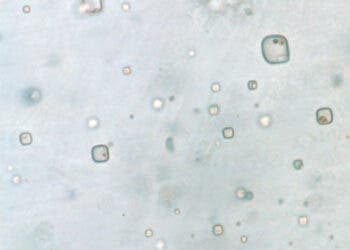Salar de Uyuni is the world’s largest salt flat (or desert). Its surface is tessellated with hexagonal crystals resulting from the evaporation of saltwater. But why are these salt crystals perfectly cubical?
To get through that, we need to look not only at this desert but at the salt itself.

But first, the desert
The story of Salar de Uyuni begins millions of years ago, when the Andes Mountains rose, altering the flow of water in the region. These mountains were created by the tug and pull of the tectonic plates, two of which smacked into each other, raising above and forming the Andes.
As a result of these changes, ancient lakes, including Lake Minchin, which once covered the area, started to evaporate. Over thousands of years, as these lakes dried up, they left behind a thick crust of salt and minerals. What remained is a surreal landscape, flat and blindingly white, that covers an area larger than some small countries.

The salt flat’s formation is a direct result of the area’s geological past. However, the story of this desert is much deeper — literally.
Salar de Uyuni is not just a flat expanse; it is layered with salt up to ten meters thick in some places. Beneath this salty surface lies a pool of brine, rich in lithium, a key element in batteries. As the world shifts toward green energy, this lithium reserve has become a valuable asset, drawing both scientific interest and economic opportunity.
But let’s not diverge.
The desert is now covered by a salt crust that’s thick and also extremely flat. Over the entire area of the salar (10,582 square kilometres or 4,086 sq mi), the elevation varies within one meter. This exceptional flatness makes it ideal for calibrating the altimeters for Earth observation satellites.
The environmental conditions at Salar de Uyuni also led to the formation of a striking geometrical structure: hexagonal patterns.

Large-scale hexagonal structures of salt
The salt flat’s surface is exposed to extreme conditions, with daytime temperatures often soaring and nighttime temperatures dropping sharply. This daily thermal cycling creates the perfect environment for the process of expansion and contraction that gives rise to the hexagonal shapes.
During the day, the intense sunlight heats the surface of the salt flat, causing it to expand. As the temperature drops at night, the salt cools and contracts. This cycle of heating and cooling creates stress on the salt crust, leading to the formation of cracks. Over time, these cracks develop into the geometric shapes that we see today.
But why hexagons? The answer lies in the efficiency of packing and minimizing energy. In nature, hexagons are a common solution to efficiently fill a plane with equal-sized units while minimizing perimeter.

On the salt flat, as the salt crust contracts, it naturally cracks in a way that minimizes energy. Hexagons are the optimal shape for this, as they allow for the most compact and stable configuration with the least amount of stress on each side. A somewhat similar process also leads to the columnar, hexagonal basalt columns.
OK but why are the salt crystals cubic?

Salt, or sodium chloride (NaCl), consists of two elements: sodium (Na) and chlorine (Cl). Each of these atoms carries an electrical charge—sodium is positively charged (a cation), and chlorine is negatively charged (an anion). When these oppositely charged ions come together, they form a strong ionic bond. This bond is the foundation of salt’s crystal structure.
In a sodium chloride crystal, the sodium and chlorine ions arrange themselves in a repeating pattern known as a lattice. Specifically, NaCl forms a “face-centered cubic” (FCC) lattice structure. In this configuration, each sodium ion is surrounded by six chlorine ions, and six sodium ions surround each chlorine ion. This 1:1 ratio creates a very stable and balanced arrangement.

The cubic shape of salt crystals arises directly from this specific arrangement of ions. Because each ion is symmetrically surrounded by six ions of the opposite charge, the forces holding the crystal together are equally distributed in all directions. This uniform distribution of forces results in a crystal shape that is also uniform in all three dimensions—hence, a cube.
Imagine stacking blocks in a 3D grid. If each block represents an ion, and you stack them so that each block is surrounded by an equal number of opposite-charge blocks, the resulting structure would naturally form a cube. This is essentially what happens on the atomic level in a salt crystal. The cubic shape minimizes the energy of the system, creating a stable and tightly packed structure that resists breaking apart.

Is salt the only special cubic mineral?
While salt is a familiar example of a cubic crystal, it’s just one of many minerals that naturally adopt this shape. Other minerals like pyrite, fluorite, galena, magnetite, and spinel also form cubic crystals, each with unique properties and compositions. The common thread among all these minerals is their atomic structure and the symmetry of their crystal lattice, which dictate their cubic shapes.
The cubic crystal system is one of the seven crystal systems in crystallography, and it includes several minerals with distinct characteristics and compositions. The cubic crystal system is characterized by three axes of equal length intersecting at right angles. This high level of symmetry makes cubic crystals unique compared to other crystal systems, which may have axes of differing lengths or intersect at angles other than 90 degrees.

Minerals that crystallize in the cubic system, like salt, pyrite, fluorite, galena, magnetite, and spinel, often exhibit a high degree of structural stability and symmetry — although they are not always exactly cubes.
In the end, the story of why salt crystals are cubic comes down to the fundamental forces and arrangements at the atomic level. The cubic structure of NaCl is not a mere coincidence but a natural consequence of how sodium and chloride ions bond and arrange themselves in the most stable, energetically favorable configuration.
This same principle of symmetry and efficiency applies across the vast expanse of Salar de Uyuni, where the interplay of natural forces creates both the striking hexagonal patterns on the ground and the microscopic cubic crystals of salt.






